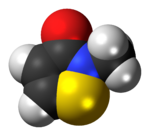Type: Toxin
Name: Methylisothiazolinone
RDA: 0
Importance- to Body:
Toxin: Respiratory, Skin
Distribution- in Body:
Skin, Respiratory System, Areas Applied
Excess Effects:
Lung Toxicity, Allergic reactions, Nerve Damage, Nerve Toxicity
Deficiency Effects:
None Listed
Food Sources:
None Listed
Environmental/Geographic Sources:
Detergents, Hairspray, Shaving Cream, Mascara, Sunscreen, Champoo, Hair Conditioner, Makeup Remover, Body Wash, Baby Lotion, Baby Shampoo
Supplemental information:
Preservative, Biocide
Works Cited:
“Methylisothiazolinone.” American Chemical Society, www.acs.org/content/acs/en/molecule-of-the-week/archive/m/methylisothiazolinone.html.

| |

| |
| Names | |
|---|---|
| Preferred IUPAC name
2-Methyl-1,2-thiazol-3(2H)-one | |
| Other names
2-Methylisothiazol-3(2H)-one
2-Methyl-4-isothiazolin-3-one | |
| Identifiers | |
3D model (JSmol)
|
|
| Abbreviations | MIT |
| ChEBI | |
| ChemSpider | |
| ECHA InfoCard | 100.018.399 |
| EC Number | 220-239-6 |
PubChem CID
|
|
| UNII | |
| |
| |
| Properties | |
| C4H5NOS | |
| Molar mass | 115.1 g/mol |
| Hazards | |
| S-phrases (outdated) | (S2) S26 S28 S36/37/39 S45 S60 S61 |
| R/S statement (outdated) | R23/24/25 R34 R43 R50/53 |
Except where otherwise noted, data are given for materials in their standard state (at 25 °C [77 °F], 100 kPa). | |
| Infobox references | |
Methylisothiazolinone, MIT, or MI, (sometimes erroneously called methylisothiazoline), is a powerful synthetic biocide and preservative within the group of isothiazolinones, which is used in numerous personal care products and a wide range of industrial applications.
It is a cytotoxin that may affect different types of cells. Its use for a wide range of personal products for humans, such as cosmetics, lotions, moisturizers, sanitary wipes, shampoos, and sunscreens, more than doubled during the first decade of the twenty-first century and has been reported as a contact sensitizing agent by the European Commission’s Scientific Committee on Consumer Safety.
Industrial applications also are quite wide ranging, from preservative and sanitizing uses to antimicrobial agents, energy production, metalworking fluids, mining, paint manufacturing, and paper manufacturing, many of which increase potential exposure to it by humans as well as organisms, both terrestrial and marine. Industrial applications in marine environments are proving to be toxic to marine life, for instance, when the effect of its now almost-universal use in boat hull paint was examined.

